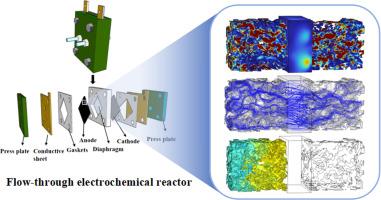揭示了空间受限流动电化学反应器中的流体动力学和传质过程
IF 6.3
2区 环境科学与生态学
Q1 ENVIRONMENTAL SCIENCES
引用次数: 0
摘要
电催化氧化是一种很有前途的污水处理技术,但传质差和电流效率低阻碍了其工程应用。为了解决这些问题,研究人员开发了主要基于多孔电极的流动电化学反应器(FERs),其中孔隙结构对电化学反应有显著影响。因此,本研究系统地研究了不同孔径对fe的流体动力学、电流势分布、传质过程和降解性能的影响。计算流体动力学(CFD)结果表明,孔径较小(10 μm、30 μm和60 μm)显著增强了流体内部的对流效应,减少了微通道内的短流道和死体积区域,有利于传质过程。此外,较小的孔径有利于电流密度的均匀分布。此外,Fe(CN)64−氧化实验表明,160 μm孔径下的电流密度明显低于10 μm孔径下的电流密度,表明Fe(CN)64−在较大孔道内的传质速度较慢。基于实验结果的计算表明,孔径为10 μm时的传质速率是孔径为160 μm时的6倍,进一步证实了孔径较小对传质过程的增强作用。最后,对四环素的降解实验表明,在停留时间为90 s时,孔径为10 μm和160 μm的多孔电极对四环素的去除率分别为80%和39.1%,表明孔径较小的电极对四环素的降解效率更高。本文章由计算机程序翻译,如有差异,请以英文原文为准。

Unveiling the fluid dynamics and mass transfer processes in a spatially confined flow-through electrochemical reactor
Electrocatalytic oxidation is a promising technology for wastewater treatment, but poor mass transfer and low current efficiency impaded its engineering applications. To address these issues, researchers have developed flow-through electrochemical reactors (FERs) primarily based on porous electrodes, where the pore structure significantly impacts the electrochemical reaction. Therefore, this study systematically investigated the impact of different pore sizes on the fluid dynamics, current potential distribution, mass transfer processes, and degradation performance of FERs. Computational Fluid Dynamics (CFD) results indicated that smaller pore sizes (10 μm, 30 μm, and 60 μm) significantly enhanced convective effects within the fluid, reduced short fluid paths and dead volume regions within the microchannels, and facilitated mass transfer processes. Additionally, smaller pore sizes were conducive to a uniform distribution of current density. Furthermore, Fe(CN)64− oxidation experiments revealed that the current density at a pore size of 160 μm was notably lower than that at 10 μm, indicating slower mass transfer of Fe(CN)64− within larger channels. Calculations based on experimental results demonstrated that the mass transfer rate at a pore size of 10 μm was six times than that at 160 μm, further confirming the enhancing effect of smaller pore sizes on the mass transfer process. Lastly, experiments on tetracycline degradation showed that at a residence time of 90 s, the removal efficiencies of tetracycline were 80 % and 39.1 % for porous electrodes with pore sizes of 10 μm and 160 μm, respectively, demonstrating the superior removal efficiency of smaller pore sizes for tetracycline degradation.
求助全文
通过发布文献求助,成功后即可免费获取论文全文。
去求助
来源期刊

Journal of Environmental Sciences-china
环境科学-环境科学
CiteScore
13.70
自引率
0.00%
发文量
6354
审稿时长
2.6 months
期刊介绍:
The Journal of Environmental Sciences is an international journal started in 1989. The journal is devoted to publish original, peer-reviewed research papers on main aspects of environmental sciences, such as environmental chemistry, environmental biology, ecology, geosciences and environmental physics. Appropriate subjects include basic and applied research on atmospheric, terrestrial and aquatic environments, pollution control and abatement technology, conservation of natural resources, environmental health and toxicology. Announcements of international environmental science meetings and other recent information are also included.
 求助内容:
求助内容: 应助结果提醒方式:
应助结果提醒方式:


